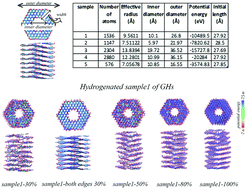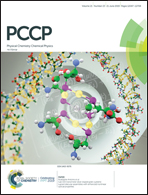Hydrogenation-controlled mechanical properties in graphene helicoids: exceptional distribution-dependent behavior†
Abstract
The ever-increasing development of nanotechnology has led to the creation of nanomaterials with spiral geometry such as graphene helicoids (GHs) that are mainly used for mechanical, chemical, and electrical applications. Controlling the properties of these nanomaterials with geometric changes and functionalizations is the most common and accessible task. However, functionalization leads to specific applications. In the present research, using molecular dynamics simulation, mechanical properties of pristine and functionalized GHs have been investigated for various geometries and H-coverages. Also, hydrogenation has been performed for patterned and random distributions. The random H-coverage up to 10 percent results in a decrease in the Young's modulus. Also, by increasing the percentage of H-coverage beyond 10 percent, no conspicuous alteration is observed in the Young's modulus, while the ultimate strain is reduced. By examining the effect of temperature rise on the properties of pristine and functionalized GHs, a sharp decrease in the strain range is observed for both. In addition, it has been shown that the toughness is severely reduced by decreasing the external and internal radii of pristine and functionalized GHs. Investigating the mechanical properties of pristine and hydrogenated GHs leads to better control of the mechanical properties of these nanoparticles and optimal efficiency in nano-scale devices.



 Please wait while we load your content...
Please wait while we load your content...